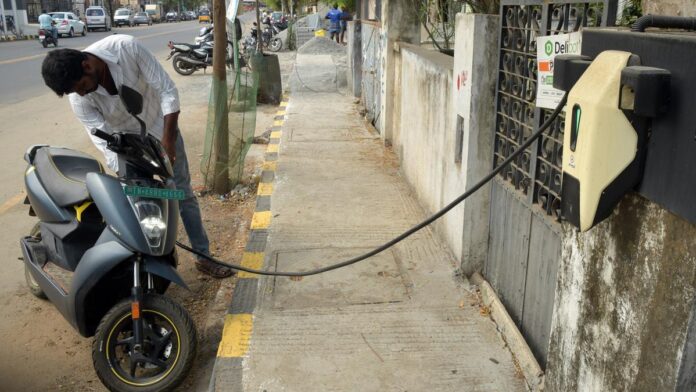
File photo of an electric vehicle charging station. Moody’s Investors Service in a report said the government needs to ramp up charging station infrastructure to reach penetration target of 30% by 2030.
| Photo Credit: MOORTHY M.
Government incentives, including those to consumers, local battery manufacturing, state-level subsidies and cuts in GST rates would help drive EV penetration in India, Moody’s has said.
In a report, Moody’s Investors Service said India has the fourth-largest car market globally, but electric vehicle (EV) penetration is currently only around 1%.
The pace of increase in EV sales and towards the government’s target of 30% by 2030 will also depend on the country’s charging infrastructure, and consumers’ readiness to switch to EVs from traditional ICE vehicles, or those traditional engines powered by petrol, diesel, or natural gas.
“We expect various government incentives will drive an increase in EV penetration. These include consumer incentives, production-linked incentives for advanced battery storage to drive local cell manufacturing, goods and services tax (GST) rate cuts, and other state-level subsidies,” Moody’s said.
India has beaten Japan to become the third-largest vehicle market in 2022 after China and the U.S.
ALSO READ | Tata Motors sees increasing EV adoption in rural India
Last month, Union Minister Nitin Gadkari had said that if India can use the lithium reserves recently discovered in Jammu and Kashmir, it can become the world’s number one automobile manufacturer in electric vehicle segment.
Lithium is a crucial element in producing batteries that power electric vehicles.
The government aims to have EV sales accounting for 30% of private cars, 70% for commercial vehicles and 80% for two-and three-wheelers by 2030.
Moody’s said Tata Motors retains an early mover advantage in the battery EV market in India, with a 85% share (April-December 2022).
Presence through 250 dealers across 165 cities, and with close to 4,300 charging points, has already allowed the company to sell some 50,000 EVs, Moody’s said.
Tata said it plans to increase its EV line-up from four models to 10, by March 2026. Tata’s EV business has already raised $1 billion from private-equity investor TPG, it added.
Last year, global battery electric vehicle sales were around 8 million, with 65% of these in China. Europe represented nearly 20%. Consumers in those regions benefited from the government incentives and automakers’ expanded product offerings, Moody’s said.
“We expect Battery Electric Vehicles’ (BEVs) share of global light vehicle sales will grow from around 10% of new vehicle registrations currently to more than one-third by 2030 and to nearly half by 2035,” it added.
#Govt #incentives #drive #penetration #India #charging #infrastructure #key #Moodys
